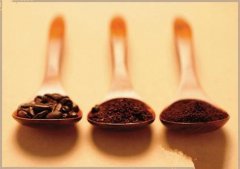The relationship between baking pattern and flavor

Now, with the understanding of the relevant words in the previous parts, we will show you the relationship between the various baking patterns and baking depth of these anchovies, which will be introduced in terms of baking depth from shallow to deep. Again: you can also see summary-style simple reference information in the charts on pages 80-81 of this book.
. The lightest roasted coffee beans are generally called cinnamon roasting degree. The highest roasting temperature of the bean heart is no more than 400 degrees Fahrenheit / 205C, and the caramelization degree of SCAA is "# 95". At this time, the appearance of coffee beans is very light brown, and the cup usually has a strong acidity like wax acid, weak aroma, shell taste and thin stickiness. The surface of coffee beans is dry and oil-free.
. The shallow roasting, which is slightly deeper than the previous stage, is called New England baking, and the highest temperature of the bean heart is about 400F / 205C, which is "# 85" in terms of the caramelization of SCAA, when the acidity in the coffee cup is very strong, and the flavor uniqueness of the coffee bean itself (Varietal characteristics, usually accompanied by acidity) will emerge. At this time, there is an obvious feeling of viscosity, but it is inferior to that of deep baking. The surface of the coffee bean is still dry and oil-free, but the flavor oil has quietly developed inside the coffee bean.
. A darker, medium-light brown baking that captures the degree of baking is called light baking. In the category of American baking, the highest temperature of bean heart is between 400C and 415C (205Mel 215 degrees Celsius), and the degree of caramelization of SCAA is between "# 75" and "# 65". The acidity is bright, but it is no longer too strong, the flavor uniqueness of coffee beans is still retained, and the consistency is fuller. In the eyes of traditional East Coast coffee drinkers, coffee beans in this roasting mode are the "best coffee".
. En than the former is a little deeper, medium brown baking catches the degree of baking, which is called medium baking, medium-high baking, or urban baking, which is within the range of American baking. The highest temperature of bean heart is between 415-435 degrees Fahrenheit (215-225 degrees Celsius). According to the degree of caramelization of SCAA, the acidity is still obvious, but the taste is relatively rich. At this time, the unique flavor of coffee beans gradually weakens, and the consistency is fuller. This is the traditional universal baking model in the western United States.
. Then a deeper baking depth is called "deep city baking". The highest temperature of the bean heart is between 435 and 455 degrees Fahrenheit, and between "# 55" and "# 45" in terms of the caramelization degree of SCAA, the acidity weakens slightly and the consistency becomes thicker. At this baking depth, the coffee bean itself is unique except for the acidity of Kenyan coffee beans, such as red wine. Almost imperceptible. Some of the more delicate features, such as the elusive smoky flavor of some coffee beans from Guatemala, are easily lost by roasting.
At this baking depth, a new flavor begins to emerge, which is a special flavor that can only be found in deep-roasted coffee beans. There is no special term in the general comments, but the author has a name for this flavor. It's called "bitter and sweet". There is a sugar flavor in the coffee beans that begins to develop, giving the coffee beans at this baking depth a delicate sweetness, which is not quite the same as the sweetness of granulated sugar, but closer to the texture of caramel. at the same time, the performance of acidity is transformed into the expression of irritating flavor, a combination of these flavors that deep roasting lovers are familiar with.
At this time, the bean table may still be dry, or it may begin to appear sporadic oil spots, which are just about to emerge from the inside of the coffee beans. The most popular baking depth in the northwestern United States and Northern California is currently available in Starbucks coffee shops across the United States.
. To the degree of ordinary deep baking, which is called Espresso baking, European baking, or high baking, the highest temperature of bean heart is between 445C and 455C, and the caramelization degree of SCAA is between "# 45" and "# 35". At this time, the acidity has been completely wrapped in a strong sense, and the flavor uniqueness of coffee beans can no longer be distinguished and full-bodied. The bitter taste of deep-roasted coffee beans is also getting stronger and longer. At this baking depth, there must be oil on the surface of coffee beans, from sporadic oil spots to the extent of a thin film.
. When the coffee beans are roasted to a very deep roasting degree, such as French roasting, Italian roasting, deep roasting, etc., the highest temperature of the bean heart is between 455 and 465 degrees Fahrenheit (235C-240C). According to the caramelization degree of SCAA, it is "# 35". The bitter taste or deep-roasted coffee bean taste occupies the whole picture, the consistency gradually weakens, the acidity and the flavor uniqueness of the coffee bean itself. All have been overshadowed by a strong bitter taste, with acidity ranging from round and soft (coffee beans with lower acidity) to the tipping point of bitterness (coffee beans with higher acidity). At this roasting depth of coffee beans, the bean table is always shiny.
. When it comes to the stage of very deep baking, such as Italian baking, deep French baking, Spanish baking or re-baking, the highest temperature of bean heart is between 450C and 475C (245C to 245C), and the degree of caramelization of SCAA is between "# 35" and "# 25". The viscosity of the surface becomes weaker and weaker, while the oil on the bean surface begins to be highly evaporated. At this baking depth, the critical point of bitterness in the performance of bitter sweet taste, there is also a hint of scorched taste in the bosom, not to mention the acidity and the flavor uniqueness of coffee beans, which has long been a member of the deep-roasted flavor level. The bean surface is shiny, and the flavor oil is blown out of the bean surface.
In addition to the thin consistency and the deep-roasted taste of the dominant flavor, these very deep-roasted coffee beans are very exciting and enjoyable for those who prefer this flavor. Coffee beans at this roasting depth are ideal for making lattes with milk or other coffee drinks mixed with milk.
. Finally, there is the stage of very deep roasting, the appearance of coffee beans is close to black, probably only deep French roasting and Spanish roasting will roast coffee beans to this extent, the highest temperature of beans is between 475 and 480 degrees Fahrenheit (245C-250C), according to the caramelization degree of SCAA, it is "# 25". Very deeply roasted coffee beans must have a very special taste. With a thinner consistency, deep-roasted beans are bittersweet, with a higher proportion of bitterness and less sweetness, and the whole cup of coffee is full of charred and charcoal. No matter where the coffee beans come from, once they are roasted to a very deep stage, the flavor is almost exactly the same. The oil on the bean table is bright and smooth, and deep roasting like this is basically not used for brewing espresso. Espresso beans are deep-roasted beans, yes, but not completely blackened. Still have a good consistency and sweetness performance. People who roast coffee beans at home, whether or not you deliberately bake such a handful of very deep-roasted coffee beans, you will accidentally bake such a thing sooner or later in the process of playing.
Beyond the previous stage of baking, it is already coke, not coffee beans. There is no sign of consistency at all. it tastes like charred rubber soaking water, and even the oil on the bean table has been roasted dry. A batch of beans like this are not worth boiling at all.
Important Notice :
前街咖啡 FrontStreet Coffee has moved to new addredd:
FrontStreet Coffee Address: 315,Donghua East Road,GuangZhou
Tel:020 38364473
- Prev

Flavor characteristics of coffee vocabulary related to harvest
Sweet / raw / grassy (Sweet/Green/Grassy): coffee beans made from fully ripe coffee fruits usually have a natural sweet taste, but coffee beans made from immature fruits have a thin stickiness, raw and grassy flavor, and are generally accompanied by tongue-biting astringency.
- Next

Time / temperature ratio and other subtle influence properties
All roasting modes are different because of the roasting process, so even coffee beans that look the same in appearance behave very differently in the cup. When you bake a coffee bean to a fixed roasting color in a short time with fast heat / high temperature (or a combination of air flow high temperature and fast air flow), the roasted coffee bean retains more acidity.
Related
- Beginners will see the "Coffee pull flower" guide!
- What is the difference between ice blog purified milk and ordinary milk coffee?
- Why is the Philippines the largest producer of crops in Liberia?
- For coffee extraction, should the fine powder be retained?
- How does extracted espresso fill pressed powder? How much strength does it take to press the powder?
- How to make jasmine cold extract coffee? Is the jasmine + latte good?
- Will this little toy really make the coffee taste better? How does Lily Drip affect coffee extraction?
- Will the action of slapping the filter cup also affect coffee extraction?
- What's the difference between powder-to-water ratio and powder-to-liquid ratio?
- What is the Ethiopian local species? What does it have to do with Heirloom native species?

